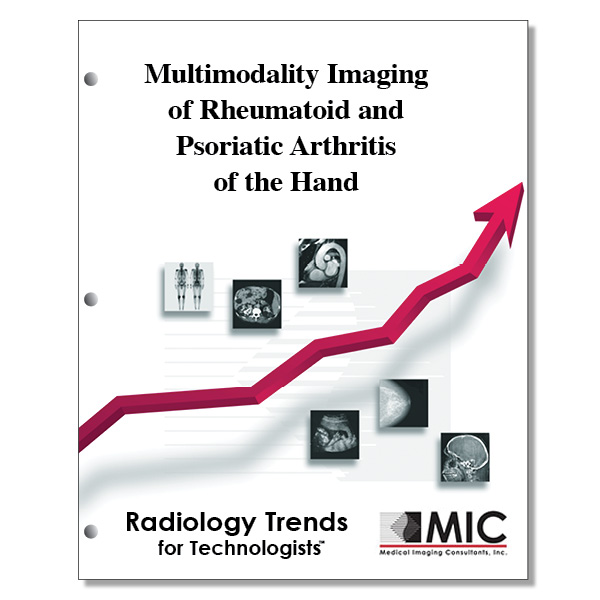

Multimodality Imaging of Rheumatoid and Psoriatic Arthritis of the Hand
A review of the contemporary role of imaging in the diagnosis and treatment of the two types of inflammatory arthritis that involve the hand joints.
Course ID: Q00670 Category: Radiology Trends for Technologists Modalities: CT, MRI, Radiography, Sonography2.0 |
Satisfaction Guarantee |
$24.00
- Targeted CE
- Outline
- Objectives
Targeted CE per ARRT’s Discipline, Category, and Subcategory classification:
Computed Tomography: 2.00
Procedures: 2.00
Head, Spine, and Musculoskeletal: 2.00
Magnetic Resonance Imaging: 2.00
Procedures: 2.00
Musculoskeletal: 2.00
Radiography: 2.00
Procedures: 2.00
Extremity Procedures: 2.00
Registered Radiologist Assistant: 2.00
Procedures: 2.00
Musculoskeletal and Endocrine Sections: 2.00
Sonography: 2.00
Procedures: 2.00
Superficial Structures and Other Sonographic Procedures: 2.00
Outline
- Introduction
- Pathophysiology
- Synovio-Entheseal Complex
- Imaging Modalities
- Radiography
- Ultrasonography
- Magnetic Resonance Imaging
- CT and Dual-Energy CT
- Systematic Approach to Differentiate RA and PsA of the Hand: Multimodality Imaging Characteristics
- Alignment
- Bone Change: Bone Density, Erosion, and Proliferation
- Bone Marrow Edema
- Cartilage Damage
- Distribution
- Effusion with Synovitis or Enthesitis
- Summary of Imaging Features
- Conclusion
Objectives
Upon completion of this course, students will:
- be familiar with the percentage of RA patients with negative test results for rheumatoid factor
- be familiar with the factors associated with the development of RA and PsA
- identify the most investigated cytokines in RA
- be familiar with the inhibitors for PsA
- understand the synovio-entheseal complex
- identify the primary imaging modality for evaluating inflammatory arthritis
- identify the imaging modality of choice when evaluating arthritis, even when findings at radiography are unremarkable
- be familiar with the limitations of using US to evaluate patients presenting with RA or PsA
- identify the imaging modality with higher sensitivity than radiography and US for detecting bone erosions
- be familiar with MRI sequences used for diagnosing inflammatory arthritis
- identify the imaging modality regarded as the standard examination when evaluating structural changes in patients presenting with RA or PsA
- be familiar with dual-energy CT processing techniques used to depict inflammatory lesions in inflammatory arthritis
- be familiar with the mnemonic ABCDE used when interpreting images of RA or PsA patients
- be familiar with the deformities most frequently found in RA patients
- be familiar with the swan neck deformity
- be familiar with the development of bone erosions within 1 year after the onset of RA
- be familiar with the bone formation associated with patients presenting with PsA
- be familiar with the pencil-in-cup deformity in patients presenting with PsA
- identify the MRI sequences used to assess bone marrow edema
- identify the mouse ear sign associated with PsA
- identify the pencil-in-cup deformity associated with patients presenting with PsA
- be familiar with the advantages of dual-energy CT for assessing bone marrow edema
- be familiar with the result of cartilage results on medical imaging
- identify the imaging modality used for evaluating joint spaces
- be familiar with the imaging patterns of inflammation associated with dactylitis
- be familiar with the imaging modalities of choice for diagnosing effusion in the joint
- be familiar with the use of MRI contrast when diagnosing effusion
- be familiar with the administration of MRI contrast when differentiating between synovium and joint fluid
- be familiar with the MRI sequences used to diagnose synovitis in patients with RA
- identify the imaging modality that allows detailed visualization of the proliferated synovium and perfusional changes induced by synovitis
- be familiar with the findings of Gutierrez et al
- be familiar with the imaging feature of tenosynovitis
- identify the imaging modality found to be superior in demonstrating inflammatory lesions in small joints
- identify the imaging modalities used for diagnosing inflammatory lesions
- be familiar with the findings of sacroiliitis in patients presenting with RA
